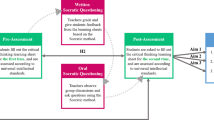Abstract
Medicine is a life-long learning and thinking profession. To develop future physicians into autonomous learners and thinkers, medical educators must apply interactive and thought-provoking pedagogies to medical training. Socratic questioning is a teaching methodology that develops deep knowledge and critical thinking skills vital to the art of medicine.
Access this chapter
Tax calculation will be finalised at checkout
Purchases are for personal use only
Similar content being viewed by others
References
Paul R, Elder L. The thinker’s guide to the art of socratic questioning. Tomales, CA: The Foundation for Critical Thinking; 2006.
Paul R, Elder L. Critical thinking: the art of socratic thinking, part III. J Dev Educ. 2008;31(3):34–5.
Elder L, Paul R. The role of socratic questioning in thinking, teaching and learning. Clearing House. 2010;71(5):297–301.
Fornari A. Socratic questioning. Hofstra North Shore-LJ School of Medicine Faculty Development. Powerpoint.
Irby D. What clinical teachers in medicine need to know. Acad Med. 1994;69(5):333–42.
Zou L, King A, Soman S, Lischuk A, Schneider B, Walor D, Branwit M, Amorosa J. Medical students’ preference in radiology education: a comparison between the socratic and didactic methods utilizing powerpoint features in radiology education. Acad Radiol. 2010;18(2):253–6.
Bloom B, Mesia B, Krathwohl D. Taxonomy of educational objectives (2 vols.: The affective domain and The cognitive domain). New York: David McKay; 1964.
Anderson L, Krathwohl D, Airasian P, Cruikshank K, Mayer R, Pintrich P, Raths J, Wittrock M. A taxonomy for learning, teaching, and assessing: a revision of Bloom’s taxonomy of educational objectives (complete edition). New York: Longman; 2001.
Suggested Reading
Marcelo FDC, Raymond YK, Scott DS. Chapter 229: Noninvasive cardiac imaging. In: Longo DL, Fauci AS, Kasper DL, Hauser SL, Jameson JL, Loscalzo J, editors. Harrison’s principles of internal medicine [Internet]. 18th ed. New York: McGraw-Hill; 2012 [cited 2014 Mar 28]. p. 1841–52.
Drake RL, Vogl AW, Mitchell AWM. Chapter 3: Thorax. In: Tibbitts RM, Richardson P, illustrators, Horn A, photographer. Gray’s anatomy for students. 2nd ed. Philadelphia: Churchill Livingstone/Elsevier; 2010. p. 192–199.
Drake RL, Vogl AW, Mitchell AWM. Chapter 3: Thorax. In: Tibbitts RM, Richardson P, illustrators, Horn A, photographer. Gray’s anatomy for students. 3rd ed. Philadelphia: Churchill Livingstone/Elsevier; 2015 [cited 2014 Mar 28]. p. 198–205.
Kumar V, Abbas AK, Fausto N, Aster JC. Chapter 12: The heart. In: Perkins JA, illustrator. Robbins and Cotran pathologic basis of disease [Internet]. 8th ed. Philadelphia: Elsevier/Saunders; 2010 [cited 2014 Mar 28]. p. 545–60.
Moore KL, Dalley AF 2nd, Agur AMR. Chapter 1: Thorax. In: Clinically oriented anatomy. 7th ed. Philadelphia: Wolters Kluwer/Lippincott Williams & Wilkins; 2014 [cited 2014 Mar 28]. p. 144–8.
Author information
Authors and Affiliations
Corresponding author
Editor information
Editors and Affiliations
Rights and permissions
Copyright information
© 2021 The Author(s), under exclusive license to Springer Nature Switzerland AG
About this chapter
Cite this chapter
Elkowitz, D.E. (2021). Socratic Questioning to Engage Learners. In: Fornari, A., Poznanski, A. (eds) How-to Guide for Active Learning. IAMSE Manuals. Springer, Cham. https://doi.org/10.1007/978-3-030-62916-8_9
Download citation
DOI: https://doi.org/10.1007/978-3-030-62916-8_9
Published:
Publisher Name: Springer, Cham
Print ISBN: 978-3-030-62915-1
Online ISBN: 978-3-030-62916-8
eBook Packages: EducationEducation (R0)




